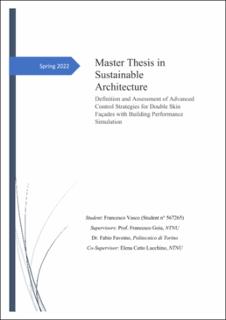| dc.contributor.advisor | Goia, Francesco (NTNU) | |
| dc.contributor.advisor | Favoino, Fabio (Politecnico di Torino) | |
| dc.contributor.advisor | Catto Lucchino, Elena (NTNU) | |
| dc.contributor.author | Vasco, Francesco | |
| dc.date.accessioned | 2022-07-20T17:20:20Z | |
| dc.date.available | 2022-07-20T17:20:20Z | |
| dc.date.issued | 2022 | |
| dc.identifier | no.ntnu:inspera:113132537:90372755 | |
| dc.identifier.uri | https://hdl.handle.net/11250/3007381 | |
| dc.description.abstract | Den økende miljøpåvirkningen fra AEC-sektoren er en av de mest utfordrende oppgavene som byggebransjen nå står overfor. Av denne grunn er designerne nå oppfordret til å finne nye teknologier og innovative prosesser for å nå det ambisiøse nivået for fullstendig avkarbonisering av byggesektoren innen 2050.
En mulig vei å følge på dette feltet er forbedring av eksisterende konvoluttteknologier. Faktisk er dynamikk og respons til ulike drifts- og sesongmessige forhold nye krav som disse nye innovative konvoluttsystemene må gi. Denne oppgaven tar for seg en spesiell typologi av denne typen konvolutter: Double Skin Fasadene.
Dynamiske konvoluttsystemer må faktisk utstyres med en kontrolllogikk som skal kunne sikre tilpasningsevnen til de forskjellige drifts- og sesongmessige forhold, og garantere både energiytelse og brukerens komfort: definisjonen og den påfølgende implementeringen av kontrolllogikken er følgelig avgjørende trinn i utformingen av denne typologien til bygningsskap. Koblet til disse konseptene, tar oppgaven sikte på å utvikle ulike kontrollstrategier for en DSF, og prøver å forstå sammenhengene mellom dem og den generelle ytelsen til bygningssystemet. Det endelige formålet er faktisk å definere styrker og svakheter ved de forskjellige implementerte kontrollene, velge den optimale løsningen som kan brukes i en viss grensetilstand. | |
| dc.description.abstract | The increasing environmental impact of the AEC sector is one of the most challenging tasks that the construction industry is now facing. For this reason, the designers are now called to find new technologies and innovative processes to reach the ambitious level of the complete decarbonization of the building sector by 2050.
A possible path to follow in this field is the improvement of the existing envelope technologies. Indeed, dynamicity and responsivity to different operating and seasonal conditions are new requirements that these new innovative envelope systems must provide. This Thesis deals with a particular typology of this kind of envelopes: the Double Skin Façades.
Dynamic envelope systems indeed must be provided with a control logic that should be able to ensure the adaptability to the different operating and seasonal conditions, guarantying both, energy performance and occupant’s comfort: the definition and the subsequent implementation of the control logic are consequently crucial steps in the design of this typology of building enclosures. Connected to these concepts, the Thesis aims to develop different control strategies for a DSF, trying to understand the interconnections between them and the overall performance of the building system. The final purpose is indeed to define strengths and weaknesses of the different implemented controls, selecting the optimal solution that can be applied in a certain boundary condition. | |
| dc.language | eng | |
| dc.publisher | NTNU | |
| dc.title | Definition and Assessment of Advanced Control Strategies for Double Skin Façades with Building Performance Simulation | |
| dc.type | Master thesis | |
